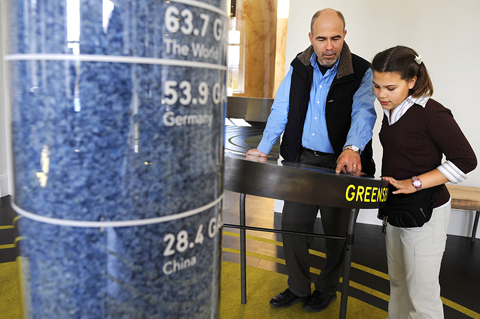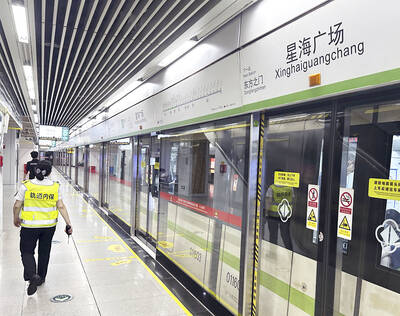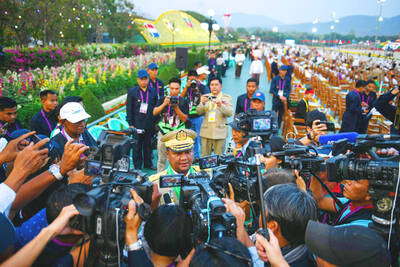Greensburg, Kansas, rebuilding from scratch after nearly being wiped away by a tornado last year, is quickly becoming a model for going green.
Along with Masdar City, a planned car-free community outside Abu Dhabi in the United Arab Emirates, and other developments, the rural Kansas town offers vivid examples of sustainable living in a “Green Community,” a new exhibit at the National Building Museum in Washington. The exhibit opened on Thursday and will run for a year.
“They are really making a wonderful opportunity out of an absolute tragedy,” curator and architect Susan Piedmont-Palladino said of Greensburg. “Masdar and Greensburg do make a really good pair because they’re both looking at the whole package of green technologies — from very old ways of doing things to high-tech ways.”

PHOTO: AP
Where windmills once dotted the Kansas landscape, Greensburg plans to embrace them again to harvest enough wind energy to power the town of about 700, which had twice as many residents before the tornado.
Greensburg gets only 56cm of rain a year, so street runoff and rainwater that hits buildings will be collected and used to irrigate plants, part of a master plan that “treats each drop of water as a precious resource,” said Stephen Hardy, a city planner with the architectural firm BNIM, which is helping with the effort.
And the town has resolved to build public buildings that meet the most stringent standards for efficient design. Even the John Deere dealership is pursuing certification from the US Green Building Council and plans to sell wind turbines for homes and businesses.
“Any time you’re trying to rebuild a town, there are huge economic hurdles,” Hardy said. “The fundamental shift in their thinking is they don’t want to build a building they’ll be paying for for 20 years. They want a building that will be paying them back.”
The Building Museum exhibit breaks some traditional rules by using no precious artifacts and few physical objects to tell the story of green communities.
Instead, it uses satellite photos, community snapshots, short documentaries and interactive displays on the myriad ways people can make their towns greener.
The center of the space is like walking through a huge bar graph.
Giant, transparent columns are filled with shredded tires or plastic bottles — materials otherwise headed to the dump. Marked on the columns are raw statistics on recycling or mass-transit use among various cities.
The numbers show Houston has the lowest recycling rate, with just 2.6 percent of the city’s trash being salvaged, while San Francisco, which has an organic composting program for food scraps, topping the chart at 70 percent.
“None of these issues are brand new,” Piedmont-Palladino said. “Ever since the Roman senate passed a law requiring water to be stored for dry periods, it sort of reminds us that ... it’s been the key to successful living forever. We have just forgotten.”
More than a dozen communities are noted in the exhibit and they offer a mosaic of green initiatives worldwide, Piedmont-Palladino said.
Atlanta, for example, is featured for its redevelopment of an old steel mill site in the walkable Atlantic Station development.
This is the Building Museum’s third in a series of green-themed exhibits, which have drawn record numbers of visitors despite the museum’s not being on the usual Washington tourism route.
Having small towns and big cities embrace environmentally friendly architecture and technologies will help change people’s minds about how realistic environmental building can be, Piedmont-Palladino said.
In Greensburg, the vision to go green has helped maintain an optimism that the town can indeed rebound from all it has lost.
“Ninety percent of the town was just gone overnight and yet the social fabric was intact, even without the buildings,” Hardy said. “That has driven them in a way that’s unlike any community I’ve worked with.”

In the sweltering streets of Jakarta, buskers carry towering, hollow puppets and pass around a bucket for donations. Now, they fear becoming outlaws. City authorities said they would crack down on use of the sacred ondel-ondel puppets, which can stand as tall as a truck, and they are drafting legislation to remove what they view as a street nuisance. Performances featuring the puppets — originally used by Jakarta’s Betawi people to ward off evil spirits — would be allowed only at set events. The ban could leave many ondel-ondel buskers in Jakarta jobless. “I am confused and anxious. I fear getting raided or even

Kemal Ozdemir looked up at the bare peaks of Mount Cilo in Turkey’s Kurdish majority southeast. “There were glaciers 10 years ago,” he recalled under a cloudless sky. A mountain guide for 15 years, Ozdemir then turned toward the torrent carrying dozens of blocks of ice below a slope covered with grass and rocks — a sign of glacier loss being exacerbated by global warming. “You can see that there are quite a few pieces of glacier in the water right now ... the reason why the waterfalls flow lushly actually shows us how fast the ice is melting,” he said.

RISING RACISM: A Japanese group called on China to assure safety in the country, while the Chinese embassy in Tokyo urged action against a ‘surge in xenophobia’ A Japanese woman living in China was attacked and injured by a man in a subway station in Suzhou, China, Japanese media said, hours after two Chinese men were seriously injured in violence in Tokyo. The attacks on Thursday raised concern about xenophobic sentiment in China and Japan that have been blamed for assaults in both countries. It was the third attack involving Japanese living in China since last year. In the two previous cases in China, Chinese authorities have insisted they were isolated incidents. Japanese broadcaster NHK did not identify the woman injured in Suzhou by name, but, citing the Japanese

RESTRUCTURE: Myanmar’s military has ended emergency rule and announced plans for elections in December, but critics said the move aims to entrench junta control Myanmar’s military government announced on Thursday that it was ending the state of emergency declared after it seized power in 2021 and would restructure administrative bodies to prepare for the new election at the end of the year. However, the polls planned for an unspecified date in December face serious obstacles, including a civil war raging over most of the country and pledges by opponents of the military rule to derail the election because they believe it can be neither free nor fair. Under the restructuring, Myanmar’s junta chief Min Aung Hlaing is giving up two posts, but would stay at the